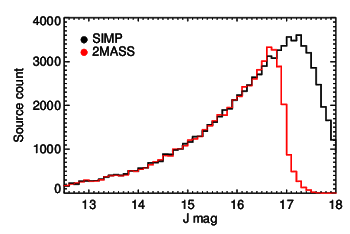Brown Dwarfs
September 22, 2016
When we think of
stars, and of our
Sun especially, we think of
light. The phrase, "
Let there be light," occurs early in the
Bible, in
Genesis 1:3. "Let there be light" is
fiat lux in
Latin, and the
lux is the
SI unit of
illuminance. In
Greek, "Let there be light" is γενηθητω φως (genetheto phos), and our word
photon is derived from φως (phos).
Not all stars are bright in
visible light.
Barnard's Star, named after
American astronomer,
Edward Emerson Barnard is a good example of this. While Barnard didn't discover this star, he found that it has the largest
proper motion of any star (10.3
arcsec/year). This large proper motion is a consequence of its proximity to the Earth, just six
light years.
Although it's just six light years away, Barnard's Star is invisible to the unaided eye, while
Alpha Centauri, a triple
star system at 4.37 light years distant, shines brightly in the
constellation,
Centaurus. The Alpha Centauri star system has gotten a lot of recent press, with the discovery of the potentially
habitable planet,
Proxima Centauri b.
The invisibility of Barnard's Star is a consequence of its being a
red dwarf (
spectral type M).
Proxima Centauri, the host star of Proxima Centauri b, is also a red dwarf. Such stars are cool stars of low
mass with a surface
temperature of less than 4,000
K. In comparison, our Sun has a surface temperature of about 5,800 K. While Barnard's Star emits very little visible light, its emission in the
short-wavelength infrared is considerable, as can be seen in the
graph.
Red dwarfs are common in our
Milky Way Galaxy, and they may constitute three-quarters of its stars. There are cooler dwarf stars, the
brown dwarfs, that are even less visible. These stars are about fifty times heavier than our
gas giant planet,
Jupiter, and they are not massive enough to
fuse hydrogen to
helium in their
cores, the principal
energy reaction of the
main sequence stars. They generate some
heat through other, minor
nuclear reactions.
Brown dwarfs are failed stars in that they are too small to sustain hydrogen
fusion. After forming, these failed stars slowly cool, contract, and dim over time.[2] Depending on its initial size, the temperature of a brown dwarf will range from as cool as a gas giant planet to nearly as hot as a star.[2] Knowledge of the
distribution of brown dwarfs is important to the understanding whether they form in isolation, or whether they are ejected from
planetary systems.[2]
Brown dwarfs are so dim that the first such star,
GD 165B, wasn't discovered until 1988. Many more brown dwarfs have been discovered since the advent of
infrared orbital observatories, such as the
Two Micron All Sky Survey (2MASS). As reported in a recent
arXiv article, the
Sondage Infrarouge de Mouvement Propre (SIMP, not to be confused with
strongly interacting massive particles), a ground-based all-sky survey in the infrared "J" band (1.220 μm wavelength), has discovered 165 brown dwarfs in close proximity to the
Earth.[1-2]
The SIMP project consists of a
southern hemisphere telescope at the
Cerro Tololo Inter-American Observatory, and a
northern hemisphere telescope at the
Observatoire du Mont-Mégantic.[1] About a third of the 165 sources discovered by SIMP had unusual compositions or other peculiarities.[2] There were six unusually red
M and
L dwarfs and twenty-five unusually blue M and L dwarfs.[1]
Says
Jonathan Gagné, an astronomer at the
Carnegie Institution of Washington and
co-author of the study,
"The search for ultracool brown dwarfs in the neighborhood of our own Solar System is far from over... Our findings indicate that many more are hiding in existing surveys."[2]
This work was supported by the
Fonds de Recherche Québécois-Nature et Technologie and the
Natural Science and Engineering Research Council of Canada.[2]
References:
- Jasmin Robert, Jonathan Gagné, Étienne Artigau, David Lafrenière, Daniel Nadeau, René Doyon, Lison Malo, Loïc Albert, Corinne Simard, Daniella C. Bardalez Gagliuffi, and Adam J. Burgasser, "A Brown Dwarf Census from the SIMP Survey," arXiv, July 28, 2016. This paper will appear in the Astrophysical Journal.
- Brown dwarfs hiding in plain sight in our solar neighborhood, Carnegie Institution for Science Press Release, September 6, 2016.
- Brown Dwarfs, Carnegie Institution YouTube Video, September 5, 2016.




